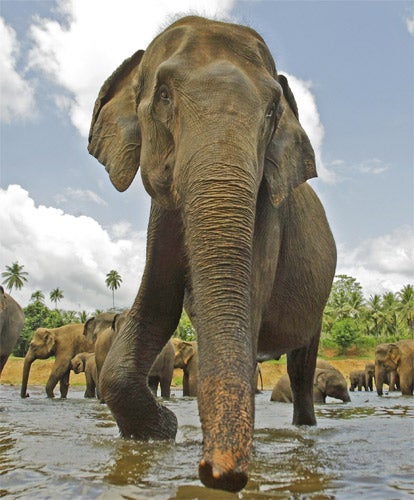How the elephant got its trunk (and other wonders of nature)
Nobel laureate to reveal secrets of evolution via massive gene-mapping project

An ambitious plan to map the genomes of 10,000 species of vertebrates – animals with backbones – has been announced by scientists.
Unravelling the DNA sequences of the many species of vertebrates will help science to explain how the leopard got its spots, how the elephant came by its trunk and how the bat learned to fly, the researchers said.
A group of eminent biologists have proposed that the "Genome 10K" project to decode 10,000 genomes – from frogs, fish and snakes, to birds, whales and monkeys – would enable scientists to tell the 600-million-year story of how vertebrates evolved from a single marine organism with the first prototype backbone into the plethora of lifeforms in the land, sea and air.
Sydney Brenner, a Nobel laureate and a senior distinguished fellow at the Salk Institute in California, said the project would help evolutionists write the missing chapters in the story of life. "The most challenging intellectual problem in biology for this century will be the reconstruction of our biological past so we can understand how complex organisms such as ourselves evolved," Dr Brenner said.
"Genomes contain information from the past. They are molecular fossils, and having sequences from vertebrates will be an essential source of rich information," he said.
The aim of Genome 10K is to collect and sequence the DNA of each vertebrate genus – the collective grouping above a species – from a database of more than 16,000 named species of vertebrate animals compiled by more than 50 institutions from around the world.
"Understanding the evolution of the vertebrates is one of the greatest detective stories in science," said David Haussler of the University of California, Santa Cruz, one of the project's architects.
"No one has ever really known how the elephant got its trunk, or how the leopard got its spots. This project will lay the foundation for work that will answer those questions and many others," Dr Haussler said. "Differences in the DNA that makes up the genomes of the animals we find today hold the key to the great biological events of the past, such as the development of the four-chambered heart and the magnificent architecture of the wings, fins and arms, each adapted to its special purpose," he said.
Each genome is likely to consist of about 3 billion DNA "bases", or chemical letters in the DNA code, which will be assigned in their correct sequence. The project has become possible because the cost of DNA sequencing has fallen greatly since the human genome was fully decoded nearly 10 years ago.
Vertebrates are one of the most "malleable" branches of life, Dr Haussler said. They evolved in the ocean but quickly spread to every habitat on land, as well as to the air in the form of birds and bats, and the sea in the shape of whales, dolphins and porpoises.
During this expansion, they produced innovative structures, such as multi-chambered hearts, bones, teeth and an articulated internal skeleton. They have also become the most intelligent of lifeforms, symbolised by the large brain and sophisticated language and culture of humans, the scientists said.
By comparing the genomes of the 10,000 vertebrates with that of humans, the scientists hope to gain insight into how man descended from his distant animal ancestors. "We can understand the function of elements in the human genome by seeing what parts of the genome have changed and what parts have not changed in humans and other animals," Dr Haussler said.
Subscribe to Independent Premium to bookmark this article
Want to bookmark your favourite articles and stories to read or reference later? Start your Independent Premium subscription today.

Join our commenting forum
Join thought-provoking conversations, follow other Independent readers and see their replies